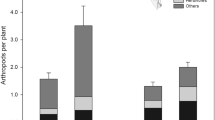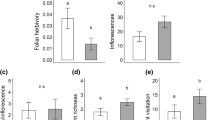Abstract
In arid environments, shade provided by vegetation forms the crux of many facilitation pathways by providing other organisms with relief from high levels of solar radiation and extreme temperatures. Shade is an important determinant that structures arid ecosystem processes and functioning. While shade is considered an essential refuge for many organisms in arid environments, few studies have assessed how parasitic plants such as aerial mistletoes can influence the quality of shade provided by its host, and how this can subsequently influence species interactions. Here, we investigate how mistletoe influences the microclimate and daytime use of sub-canopy habitat by a large herbivore that seeks out shady micro-habitats to avoid daytime heat in Australia’s Strzelecki Desert. We experimentally removed the pale-leaved mistletoe (Amyema maidenii) from mulga trees (Acacia aneura) and monitored sub-canopy ambient temperatures and the daytime use of sub-canopy habitat by red kangaroos (Osphranter rufus). Results showed that average hourly temperature during the daytime and daily maximum temperature were cooler and that kangaroos were approximately three times more likely to shelter beneath trees where mistletoe was present (control) compared to where mistletoes had been removed (treatment). By showing that mistletoe can improve the quality of shade provided by their host trees, our study offers a novel insight into how mistletoes can facilitate the surrounding biota through modifying the abiotic environment beyond its physical structure. More broadly, the results of our study emphasise the prevalence of positive interactions within ecological communities and how they can occur in unexpected ways and indirectly between organisms that never come into direct contact.




Similar content being viewed by others
References
Amat-Valero M, Calero-Torralbo MA, Václav R, Valera F. 2014. Cavity types and microclimate: implications for ecological, evolutionary, and conservation studies. Int J Biometeorol 58:1983–94.
Angelini C, Altieri AH, Silliman BR, Bertness MD. 2011. Interactions among Foundation Species and Their Consequences for Community Organization, Biodiversity, and Conservation. BioScience 61:782–9.
Bertness MD, Callaway R. 1994. Positive interactions in communities. Trends in Ecology and Evolution 9:191–3.
Bronstein JL. 2009. The evolution of facilitation and mutualism. Journal of Ecology 97:1160–70.
Bruno JF, Stachowicz JJ, Bertness MD. 2003. Inclusion of facilitation into ecological theory. Trends in Ecology and Evolution 18:119–25.
Cain JW, Krausman PR, Rosenstock SS, Turner JC. 2006. Mechanisms of Thermoregulation and Water Balance in Desert Ungulates. Wildlife Society Bulletin 34:570–81.
Callaway RM. 2007. Positive Interactions and Interdependence in Plant Communities. Dordrecht: Springer. https://doi.org/10.1007/978-1-4020-6224-7
Chapman TF. 2013. Relic bilby (Macrotis lagotis) refuge burrows: assessment of potential contribution to a rangeland restoration program. Rangel J 35:167–80.
Cooney SJN, Watson DM, Young J. 2006. Mistletoe nesting in Australian birds: a review. Emu - Austral Ornithology 106:1–12.
Davidson NJ, True KC, Pate JS. 1989. Water relations of the parasite: host relationship between the mistletoe Amyema linophyllum (Fenzl) Tieghem and Casuarina obesa Miq. Oecologia 80:321–30.
Dawson TJ. 1973. Thermoregulatory responses of the arid zone kangaroos, Megaleia rufa and Macropus robustus. Comparative Biochemistry and Physiology Part A: Physiology 46:153–69.
Dawson TJ, Denny MJS. 1969. A Bioclimatological Comparison of the Summer Day Microenvironments of Two Species of Arid-Zone Kangaroo. Ecology 50:328–32.
Dawson TJ, McTavish KJ, Munn AJ, Holloway J. 2006. Water use and the thermoregulatory behaviour of kangaroos in arid regions: Insights into the colonisation of arid rangelands in Australia by the Eastern Grey Kangaroo (Macropus giganteus). Journal of Comparative Physiology B 176:45–53.
Dean WRJ, Midgley JJ, Stock WD. 1994. The Distribution of Mistletoes in South Africa: Patterns of Species Richness and Host Choice. Journal of Biogeography 21:503.
Dean WRJ, Milton SJ, Jeltsch F. 1999. Large trees, fertile islands, and birds in arid savanna. Journal of Arid Environments 41:61–78.
Eldridge DJ, Rath D. 2002. Hip holes: kangaroo (Macropus spp.) resting sites modify the physical and chemical environment of woodland soils: KANGAROOS’ HIP HOLES AND SOILS. Austral Ecology 27:527–36.
Fillios M, Gordon C, Koch F, Letnic M. 2010. The effect of a top predator on kangaroo abundance in arid Australia and its implications for archaeological faunal assemblages. Journal of Archaeological Science 37:986–93.
Fuller A, Hetem RS, Maloney SK, Mitchell D. 2014. Adaptation to Heat and Water Shortage in Large, Arid-Zone Mammals. Physiology 29:159–67.
Fuller A, Mitchell D, Maloney SK, Hetem RS. 2016. Towards a mechanistic understanding of the responses of large terrestrial mammals to heat and aridity associated with climate change. Climate Change Responses 3:1–19. https://doi.org/10.1186/s40665-016-0024-1.
Glatzel G. 1983. Mineral nutrition and water relations of hemiparasitic mistletoes: a question of partitioning. Experiments with Loranthus europaeus on Quercus petraea and Quercus robur. Oecologia 56:193–201.
Griebel A, Watson D, Pendall E. 2017. Mistletoe, friend and foe: synthesizing ecosystem implications of mistletoe infection. Environmental Research Letters 12:115012.
Hartley SE, Green JP, Massey FP, Press MCP, Stewart AJA, John EA. 2015. Hemiparasitic plant impacts animal and plant communities across four trophic levels. Ecology 96:2408–16.
Hetem RS, Fuller A, Maloney SK, Mitchell D. 2014. Responses of large mammals to climate change. Temperature 1:115–27.
Hothorn T, Bretz F, Westfall P. 2008. Simultaneous Inference in General Parametric Models. Biometrical Journal 50:346–63.
IBM Corp. 2016. IBM SPSS Statistics for Windows, Version 24.0. Armonk, NY: IBM Corp
Keith DA. 2004. Ocean shores to desert dunes: the native vegetation of New South Wales and the ACT. Hurstville, NSW: Hurstville, NSW: Dept. of Environment and Conservation NSW
Lin B-S, Lin Y-J. 2010. Cooling Effect of Shade Trees with Different Characteristics in a Subtropical Urban Park. HortScience 45:83–6.
Ludwig J, Tongway D, Hodgkinson K, Freudenberger D, Noble J. 1996. Landscape Ecology, Function and Management: Principles from Australia’s Rangelands. CSIRO Publishing https://ebooks.publish.csiro.au/content/ISBN/9780643101159. Last accessed 02/05/2020
March WA, Watson DM. 2007. Parasites boost productivity: effects of mistletoe on litterfall dynamics in a temperate Australian forest. Oecologia 154:339–47.
Mathiasen RL, Nickrent DL, Shaw DC, Watson DM. 2008. Mistletoes: Pathology, Systematics, Ecology, and Management. Plant Disease 92:988–1006.
Mellado A, Hobby A, Lázaro-González A, Watson DM. 2019. Hemiparasites drive heterogeneity in litter arthropods: Implications for woodland insectivorous birds. Austral Ecology 44:777–85.
Michalet R, Pugnaire FI. 2016. Facilitation in communities: underlying mechanisms, community and ecosystem implications. Functional Ecology 30:3–9.
Miller JT, Andrew RA, Maslin BR. 2002. Towards an understanding of variation in the Mulga complex (Acacia aneura and relatives). 17.
Ndagurwa HGT, Ndarevani P, Muvengwi J, Maponga TS. 2016a. Mistletoes via input of nutrient-rich litter increases nutrient supply and enhance plant species composition and growth in a semi-arid savanna, southwest Zimbabwe. Plant Ecology 217:1095–104.
Ndagurwa HGT, Nyawo E, Muvengwi J. 2016b. Use of mistletoes by the Grey Go-away-bird (Corythaixoides concolor, Musophagidae) in a semi-arid savannah, south-west Zimbabwe. African Journal of Ecology 54:336–41.
Norton DA, Smith MS. 1999. Why might roadside mulgas be better mistletoe hosts? Austral Ecology 24:193–8.
Pahl L. 2019. Macropods, feral goats, sheep and cattle. 2. Equivalency in what and where they eat. The Rangeland Journal 41:519.
Press MC, Phoenix GK. 2005. Impacts of parasitic plants on natural communities: Tansley review. New Phytologist 166:737–51.
R Core Team. 2020. R: A language and environment for statistical computing. Vienna, Austria: R Foundation for Statistical Computing https://www.R-project.org/
Roberts JA, Coulson G, Munn AJ, Kearney MR. 2016. A continent-wide analysis of the shade requirements of red and western grey kangaroos. Temperature 3:340–53.
Stachowicz JJ. 2001. Mutualism, Facilitation, and the Structure of Ecological Communities. BioScience 51:235.
Terrien J. 2011. Behavioral thermoregulation in mammals: a review. Frontiers in Bioscience 16:1428.
Ullmann I, Lange OL, Ziegler H, Ehleringer J, Schulze E-D, Cowan IR. 1985. Diurnal courses of leaf conductance and transpiration of mistletoes and their hosts in Central Australia. Oecologia 67:577–87.
Venables WN, Ripley BD. 2002. Modern Applied Statistics with S. 4th edn. New York: Springer.
von Arx G, Dobbertin M, Rebetez M. 2012. Spatio-temporal effects of forest canopy on understory microclimate in a long-term experiment in Switzerland. Agricultural and Forest Meteorology 166–167:144–55.
Watson D M. 2019. Mistletoes of Southern Australia. 2nd ed. CSIRO Publishing
Watson DM. 2001. Mistletoe—A Keystone Resource in Forests and Woodlands Worldwide. Annual Review of Ecology and Systematics 32:219–49.
Watson DM. 2009. Determinants of parasitic plant distribution: the role of host quality. Botany 87:16–21.
Watson DM. 2015. Disproportionate Declines in Ground-Foraging Insectivorous Birds after Mistletoe Removal. Umapathy G, editor. PLOS ONE 10:e0142992.
Watson DM. 2016. Fleshing out facilitation–reframing interaction networks beyond top-down versus bottom-up. New Phytologist 211:803–8.
Wilson D, Read J. 2003. Kangaroo harvesters: fertilising the rangelands. The Rangeland Journal 25:47.
Zuur AF. 2009. Mixed effects models and extensions in ecology with R. New York, NY: Springer.
Acknowledgements
The authors thank all the volunteers and employees that assisted with the fieldwork and those that contributed towards insightful discussions (especially Caitlin Buckle and Max Campbell).
Funding
Funding was provided by Australian Research Council (Grant No. DP180101477).
Author information
Authors and Affiliations
Corresponding author
Rights and permissions
About this article
Cite this article
Chu, N., Cornwell, W. & Letnic, M. Mistletoes Facilitate a Desert Herbivore by Improving the Quality of Shade. Ecosystems 24, 1393–1401 (2021). https://doi.org/10.1007/s10021-020-00590-9
Received:
Accepted:
Published:
Issue Date:
DOI: https://doi.org/10.1007/s10021-020-00590-9




